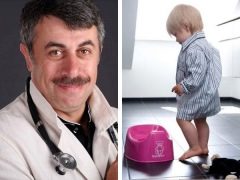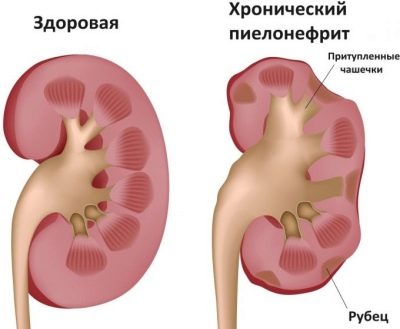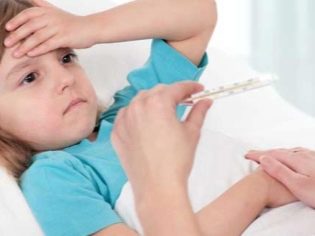Dr. Komarovsky on urinary tract infections
Urinary tract infections are considered to be the most common in our country, both in children and adults. A well-known pediatrician Yevgeny Komarovsky tells how to suspect and recognize such infections in a baby as they are, how to treat a child.
general information
Urinary tract infections (UTI) are a large group of diseases that are mostly caused by microbes that affect a particular part of the urogenital system. If a disease caused by pathogenic bacteria affects the urinary canal, they talk about urethritis. If the bladder located above is inflamed, it is cystitis. Both of these diseases are related to the lower UTI.
The defeat of the upper paths - pyelonephritis. When it affects the kidney tissue, pelvis and calyx. Simple forms of UTI are usually not accompanied by disturbances of urine outflow, whereas those complicated often occur on the background of anomalies and disturbances in the very structure of the urinary organs.
Also, infections can be both hospital (appearing after some medical manipulations) and community-acquired, which develop without prior manipulations (for example, inserting a catheter).
Children's infections are very insidious. According to Dr. Komarovsky, their identification is significantly hampered by the fact that they often occur with less pronounced symptoms than in adults. In addition, the widespread use of diapers makes it rather difficult to diagnose the primary diagnosis of the sometimes only childish symptom in infants and toddlers - frequent urination, because in the diaper, mothers simply do not notice this.
All kinds of UTIs can be acute and in children they are most often just such, but there is a risk of chronic disease, if you do not notice the disease in time, do not make a diagnosis, incorrectly treat or interrupt the treatment.
In general, urinary tract infections in childhood, according to Yevgeny Komarovsky, respond quite well and quickly to therapy.
Symptoms
In newborns and infants, such infections for unprepared parents who do not have a medical degree are often difficult to notice. Symptoms do not have clear specificity. Children become more irritable, weeping, their appetite deteriorates, and sometimes the temperature rises. The first sign is frequent urination, which is very difficult to notice in infants.
Older children, preschoolers and schoolchildren can already tell their parents about cramps, pain, frequent urination, and therefore the diagnosis is easier. Also, the child becomes irritable, may complain of chills, be apathetic. The older the children become, the more often the symptoms of urination disturbance come to the fore.
When infectious lesions of the urinary tract change the color and amount of urine, it becomes turbid or completely turbid, there is an unpleasant smell.
The reasons
The development of UTI is promoted by various congenital anomalies of the structure of the departments and organs of the urogenital system, as well as their functional disorders. Many parents believe that a child can get sick with acute pyelonephritis or cystitis from hypothermia. It is more correct to say that hypothermia provokes a decrease in immunity, and the bacteria are the trigger mechanism of the inflammatory process.
Dr. Komarovsky stresses that by stomping barefoot on the floor, a child cannot get cystitis, since the vessels of the lower extremities may narrow and thus “save” the internal heat. But sitting in the cold - a dangerous prerequisite for the development of inflammatory processes in the urinary system.
Another common premise, according to Komarovsky, is incomplete emptying of the bladder. This happens when the baby leans forward during urination. So basically the girls do, because they are sitting on the pot. It should be noted that girls are 30 times more likely to get sick with UTI illnesses also because the anatomically structure of their urethra differs from that of the boys. It is shorter, is located closer to the anus, and therefore the probability of infection with bacterial flora is higher.
Cystitis or pyelonephritis can be provoked by any ailment that undermines the state of an already weak children's immune system - SARS, influenza, etc. Separately stands the so-called neurogenic bladder - a condition in which the functions of collection and urine diversion.
How can germs get into the urinary tract of a child? There are several such methods. Most often, inflammatory processes cause intestinal wand, it can get into if it is improperly leached, the child’s hygiene is inadequate. Also, the purulent pyocyanitis, Klebsiella, proteus, enterococci, streptococci, and candida fungi can also cause inflammation of any part of the urinary tract.
Most often, the infection develops along the ascending path, from the bottom up - from the urethra to the kidneys. But infection from neighboring foci of infection is also possible, as well as through the bloodstream to the blood and lymph.
Diagnostics
In order for the child to be diagnosed appropriately, according to Komarovsky, laboratory diagnostics are necessary. Usually, a general clinical analysis of urine with urinary tract infections shows a huge number of white blood cells. Further laboratory research (bakposev) allows to establish the name of the exact causative agent of the inflammatory process. If necessary, other techniques are used to establish the exact location of the dislocation of inflammation, such as bladder x-rays with contrast, ultrasound of the bladder and kidneys.
Much accuracy of diagnosis depends on how well parents collect urine.
The child should be washed and only the middle portion of the liquid should be collected in the tank in the morning after waking up.
For bacterial culture, urine is collected in a sterile container, which is given in a medical facility. It is necessary to deliver a jar of children's urine to the laboratory of the polyclinic or children's hospital as soon as possible, because during each subsequent hour the colonies of pathogenic bacteria in it grow and grow.
If necessary, in difficult cases, the child may be recommended by MRI and CT. But the need for this arises only in case of suspicion after ultrasound of structural congenital anomalies of the urinary system, which may require surgical intervention.
According to Komarovsky, a mother should sound the alarm as soon as she suspects that something was wrong, much of the treatment prediction for UTI depends on the timeliness of the treatment. To do this, Evgeny Olegovich recommends that, as often as possible, look in diapers, evaluate the color, smell and amount of urine. If something seems suspicious, do not be shy, you should immediately show the child to the pediatrician, who first of all will prescribe a general urinalysis.
Treatment
Dr. Komarovsky encourages parents to carefully treat the treatment of such illnesses in children.
Do not cure the disease and wait until everything goes away on its own, in any case impossible. Unconventional treatment with traditional medicine - herbs, decoctions can also be dangerous.
Treatment can be outpatient and inpatient, it depends on the severity of the disease and the degree of damage. It is very important that the treatment is handled by a qualified doctor. Komarovsky argues that bacterial infections, which, in fact, are UTI, should be treated exclusively with the use of antibacterial therapy.
The treatment involved in a pediatrician, urologist, nephrologist. Begin treatment always with a change of treatment. Exercise should be limited, the amount of fluid consumed by the child should be increased - a warm and abundant drink will contribute to a more abundant urination.
Mom needs to make sure that the child every two hours empty the bladder, the stagnation of urine can increase the proliferation of bacteria.
If the infection is severe, the child may be given bed rest. During treatment, you should not give your baby pickled foods, smoked meat, but you should add to the diet foods with a high content of vitamin C to increase the acid content of urine. Antibiotics should be taken strictly according to the scheme prescribed by the doctor. Even if it gets better on the second day, you cannot refuse further course taking of antibacterial agents, since the surviving bacteria will become resistant to the drug, and the disease may become chronic.
Komarovsky claims that UTIs are treated fairly quickly, and therefore, in the absence of relief on the second day after the start of antibiotics, you should consult a doctor and find a new drug.
It is best to prescribe a particular medicine to the child after the urine of the urine, taking into account the type of pathogen. Antipyretic at high temperatures, antihistamines with strong general intoxication can be used. At the end of the treatment course, physiotherapy can be recommended.
Prevention
Urinary tract infections in a child are always easier to prevent than to cure, says Yevgeny Komarovsky, but because all parents need to know the rules of prevention of inflammatory processes of the urinary tract.
- First of all, it is important to strengthen the immune system so that even the presence of bacteria and hypothermia do not cause an inflammatory process. For this child you need to harden, make cool baths, gymnastics, often walk with him.
- Parents should promptly identify and eliminate risk factors that may contribute to the development of infection — visit the doctor, take all necessary examinations with the child in time, participate in clinical examination, and pass urine tests. This will help in time to learn about the beginning pathological processes and prevent the development of severe UTI.
- A child should be taught from an early age to the observance of personal hygiene rules: to teach how to wash properly, to wipe the ass after defecation.
- It is important to ensure that the baby does not sit on cold surfaces.
You will learn more about urinary tract infections from Dr. Komarovsky’s transmission.




























